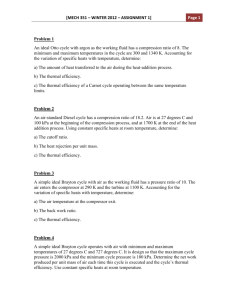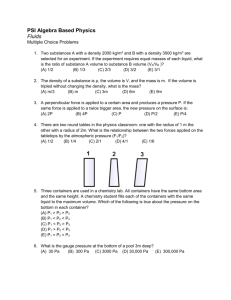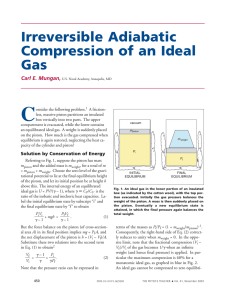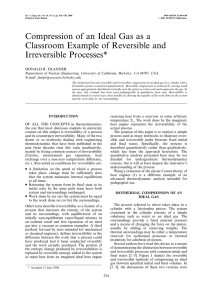Thermodynamics Problems: Air Conditioning & Heat Pumps
advertisement
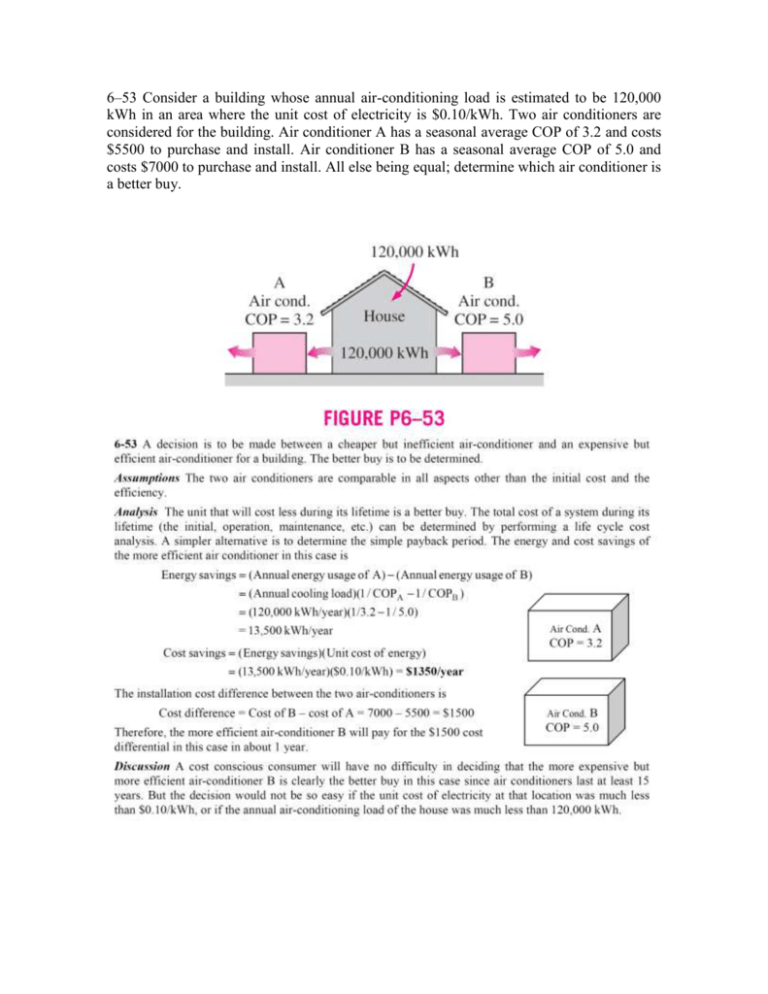
6–53 Consider a building whose annual air-conditioning load is estimated to be 120,000 kWh in an area where the unit cost of electricity is $0.10/kWh. Two air conditioners are considered for the building. Air conditioner A has a seasonal average COP of 3.2 and costs $5500 to purchase and install. Air conditioner B has a seasonal average COP of 5.0 and costs $7000 to purchase and install. All else being equal; determine which air conditioner is a better buy. 6–54 Refrigerant-134a enters the condenser of a residential heat pump at 800 kPa and 35°C at a rate of 0.018 kg/s and leaves at 800 kPa as a saturated liquid. If the compressor consumes 1.2 kW of power; determine (a) the COP of the heat pump and (b) the rate of heat absorption from the outside air. 6–56C An inventor claims to have developed a resistance heater that supplies 1.2 kWh of energy to a room for each kWh of electricity it consumes. Is this a reasonable claim, or has the inventor developed a perpetual-motion machine? Explain. 6.56C This device creates energy; therefore it is a Perpetual-Motion Machine Class 1. 6–59 C Why are engineers interested in reversible processes even though they can never be achieved? 6-59C Because reversible processes can be approached in reality, and they form the limiting cases. Work producing devices that operate on reversible processes deliver the most work, and work consuming devices that operate on reversible processes consume the least work. 6–60C Why does a nonquasi-equilibrium compression process require a larger work input than the corresponding quasi-equilibrium one? 6-60C When the compression process is non-quasiequilibrium, the molecules before the piston face cannot escape fast enough, forming a high pressure region in front of the piston. It takes more work to move the piston against this high pressure region. 6–61CWhy does a nonquasi-equilibrium expansion process deliver less work than the corresponding quasi-equilibrium one? 6-61C When an expansion process is non-quasiequilibrium, the molecules before the piston face cannot follow the piston fast enough, forming a low pressure region behind the piston. The lower pressure that pushes the piston produces less work. 6–62C How do you distinguish between internal and external irreversibilities? 6-62C The irreversibilities that occur within the system boundaries are internal irreversibilities; those which occur outside the system boundaries are external irreversibilities. 6–63C Is a reversible expansion or compression process necessarily quasi-equilibrium? Is a quasi-equilibrium expansion or compression process necessarily reversible? Explain. 6-63C A reversible expansion or compression process cannot involve unrestrained expansion or sudden compression, and thus it is quasi-equilibrium. A quasi-equilibrium expansion or compression process, on the other hand, may involve external irreversibilities (such as heat transfer through a finite temperature difference), and thus is not necessarily reversible. 6–75E A heat engine is operating on a Carnot cycle and has a thermal efficiency of 55 percent. The waste heat from this engine is rejected to a nearby lake at 60°F at a rate of800 Btu/min. Determine (a) the power output of the engine and (b) the temperature of the source. Answers:(a) 23.1 hp,(b) 1156 R 6–103 An air-conditioner with refrigerant-134a as the working fluid is used to keep a room at 26°C by rejecting the waste heat to the outdoor air at 34°C. The room gains heat through the walls and the windows at a rate of 250 kJ/min while the heat generated by the computer, TV, and lights amounts to 900 W. The refrigerant enters the compressor at500 kPa as a saturated vapor at a rate of 100 L/min and leaves at 1200 kPa and 50°C. Determine (a) the actual COP,(b) the maximum COP, and (c) the minimum volume flowrate of the refrigerant at the compressor inlet for the same compressor inlet and exit conditions. Answers: (a) 6.59, (b) 37.4, (c) 17.6 L/min







